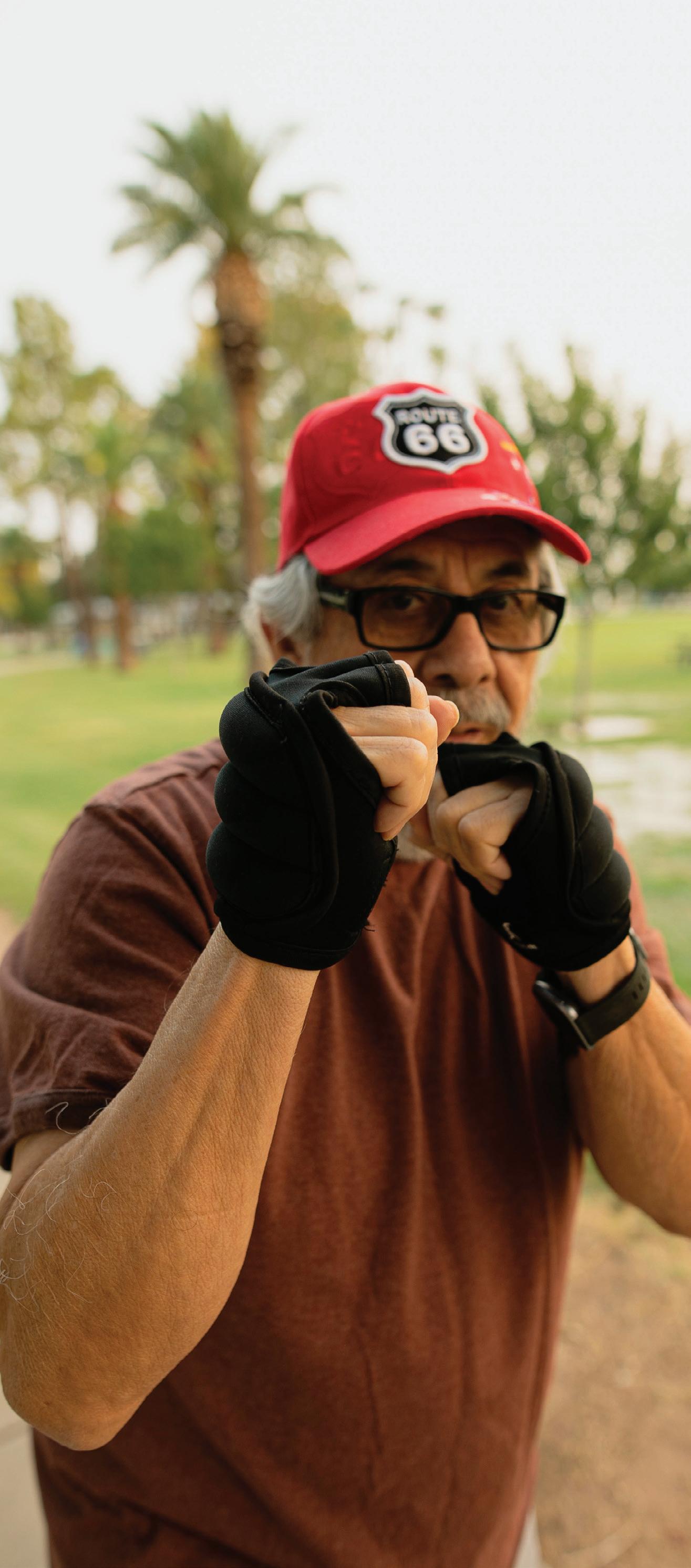
7 minute read
Working to create home-office healthy
from CORE Ink - Fall 2020
by LOCALiQ
Working on Home-Office Healthy
Find your fitness time
By Joan Westlake A s more and more people telecommute, weight gain and an increase in health issues are being attributed to working from home.
Prior to the home office boom, there were benefits from what is known as “incidental exercise,” which includes walking to and from parking areas or public transportation to get to the office, as well as moving around anchored to their cars and to talk to colleagues and desks. Walking while on perform tasks. the phone or on a treadmill or standing desk is helpful MORE TIME but doesn’t deliver the Jesse Anderson, MD, intensity for real results. FRCSC, dual trained Working from home as a joint replacement actually can contribute to and sports medicine Jesse Anderson, MD, FRCSC fitness by offering many specialist, says that even opportunities for activity. when going into an office, an exercise By telecommuting, most people gain plan should be part of a healthy lifestyle. an added hour or more in the day. While there are a few who walk or ride Commuting times in Arizona average 25 their bikes to work, most Americans are minutes. Therefore, most people have an
added hour everyday to get in a morning walk or afternoon bike ride.
MOTIVATING GADGETS Dr. Anderson points out that the gadgets, gear and fancy watches many people use to pursue such trends as counting steps and motivating weight loss may be gimmicks but they have the value of putting money where goals are. Once the latest technology, pricey running shoes, or an elite bike is bought, people tend to use the products to justify the purchase.
Whether you gear up or not, follow the World Health Organization recommendations of at least 150 minutes of moderate-intensity physical activity throughout the week, or 75 minutes of vigorous intensity. To achieve exertion in the correct moderateintensity range, look up heart rate targets by age on the American Heart Association website. To accurately track intensity, there is an endless array of technology and many treadmills and other equipment have built-in monitors. “You want to break a sweat,” Dr. Anderson said. “Set a realistic goal and pick an activity you like at a time best for you or you’ll just get frustrated and quit.”

MAKE A PLAN He stresses that one day of intense exercise is not equal to three days of moderate. Weekend warriors who do little during the week and then go for a grueling eight-hour hike, run a marathon or play aggressive contact sports usually wind up in his office with an ruptured Achilles or some other injury that is caused when the body isn’t prepared for exertion.
“Make a plan for regular exercise,” he recommends. “People often think if they don’t get 10,000 steps per day or some other more intense goal, they might as well not exercise and that thinking is counterproductive. Any activity is good. We see benefits even with an extra five to 10 minutes per day.”




Failure is Not an Option

We’ll help you get back in the swing of things with the right physical therapy plan designed specifically for you. Because with Team Rehab in your corner it isn’t over ‘til you say so.
Find a location near you at TEAM-REHAB.COM

Man of Iron!
When knee injury sidelines Ironman, The CORE Institute comes to the rescue
By Elise Riley | Photos by Michelle Massey Barnes
For the first 42 years of Ioan Dollar Man? It must be the sound Duca’s life, it would’ve been Duca heard in his head all his life. completely reasonable But then it happened. May 7, to believe his joints were 2019. Duca was doing what he made of a magical combination of did — hurling his body in the air — springs and rubber. when something went wrong.
When Duca needed to get from “I had a moment of hesitation point A to point B, he didn’t walk. doing a high jump, and basically
He’d hop. Flip. Jump. Leap. Bound. when I was up in the air, I knew
He was so active and full of energy, I wasn’t fully committed to the triathlons were just extended movement,” Duca said. “I landed jogs to him. He’d completed four it, but I landed faulty. I just heard
Ironman triathlons. That sound a crack, and I collapsed to the you heard when Lee Majors did ground.” something cool in The Six Million >>
DAMAGE DONE Duca tore his ACL — an important ligament in the knee — which he needs to perform any athletic maneuver. He also sustained tears in his meniscous in his same knee. William Kesto, MD
Duca met with William Kesto, MD of The CORE Institute, and the two began a plan to not just repair Duca’s left knee, but also to get the spring back in his step. Dr. Kesto

performed surgery to repair the damage on June 10, 2019.
“I’m someone who was always jumping, flipping, front-flip, back flip,” Duca said. “Not being able to walk was humbling and terrifying.”
PLAN FOR RECOVERY Duca worked with Dr. Kesto and Jim Watson, his physical therapist, on the best way to gradually regain strength, movement and, eventually, the type of athletic activity Duca performed daily.
“It wasn’t easy to accept the reality and to accept direction,” Duca said. “I have a Type A personality. I’m a triathlete. But I wouldn’t be able to walk for six weeks. Those six weeks were very tough, very hard.”
Jim Watson, PT stressed the importance of taking rehabilitation slowly and deliberately.
“It doesn’t matter how strong you are or how flexible you are, you can’t speed up healing,” Jim Watson, PT said.
“I’m someone who was always jumping, flipping, front-flip, back flip. Not being able to walk was humbling and terrifying.” —Ioan Duca

“When you’re dealing with an athlete who’s used to pushing their body — they’re used to feeling a healthy body, but now they’re healing. It’s especially tough with someone who’s never been hurt before. It’s all new.”
LEARNING TO WALK AGAIN At six weeks post-surgery, Duca was walking with crutches and a brace. By week 10, he was walking with just crutches.
“You forget how to walk,” Duca said. “I struggled. I didn’t think I could get my flexibility back, but I did. I had to push so hard.”
Gradually, Duca was swimming and biking. By week 13, he was running.
“I pushed through it, pushed through it, pushed through it,” Duca said.
Six months post-surgery, Duca did light tumbling in a gym. After he passed month seven, he was performing front and back flips in a foam pit. By the nine-month mark, Duca was starting to eye Ironman schedules to see when he could make his return to competition.

COMING BACK STRONGER All throughout the process, he sent Dr. Kesto videos of the running and tumbling.
“I had this unique connection with him,” Dr. Kesto said. “He’d send me updates of what he’d do in therapy, different kind of jumps and all that. Some of it was scary for me to look at, but I could see he had good control.”
While Duca’s official return to competition was delayed along with the rest of the country in 2020, he continued to heal and train. He expects to be ready, by 2021.
“This has humbled me greatly,” he said. “I don’t particularly regret going through this. I’ve learned a lot about my body and myself. I’m coming out of this stronger.”

Bilateral knee replacement surgeries get retiree back into action
The Journey Back
By Brian Sodoma
John Lopez doesn’t like to sit around much. The Arizona native was always active as a child and in his adult years. Even after retiring from a career in telecommunications, he enjoyed competing in large walking and running events to benefit charities and dabbling in different types of exercise classes; among his favorites is kickboxing.
In his 60s, however, Lopez began to develop arthritis in his knees. He turned to pain medication injections at first, but after several years of that approach his physician finally admitted that there wasn’t more that could be done. Stubbornly, he tried to persevere for a couple more years, but his knees further deteriorated, and he finally heeded his doctor’s suggestion to visit The CORE Institute.
“It got so bad I really couldn’t do anything anymore,” the now 77-year-old recalled.

BONE ON BONE As had been expected, imaging revealed cartilage in both knees was completely deteriorated, a condition commonly referred to as knees being “bone on bone,” where the femur (upper part of the leg) and tibia (lower leg bone) rub together at the knee without the natural cushion of cartilage between them.





